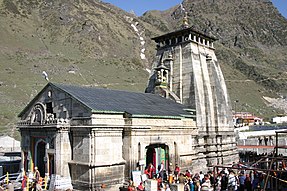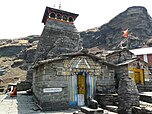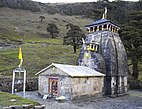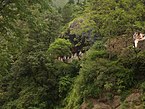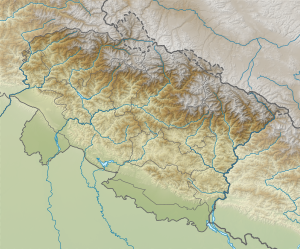Panch Kedar
| Panch Kedar | |
|---|---|
पञ्चकेदार | |
| Religion | |
Pandavas (Hindu tradition) | |
| Completed | Unknown |
| Part of a series on |
| Shaivism |
|---|
 |
|
|
Panch Kedar (
The five temples designated in the strict pecking order to be followed for pilgrimage for worship are the
The Garhwal region is also called the Kedar-Khanda after Kedar — the local name for Shiva. The region abounds in emblems and aniconic forms of Shaiva sect of Shiva, much more than the
Visitors to Kedarnath shrine, the first of the Panch Kedar temples for which records are available, was an impressive 557,923 in 2007 as against 87,629 in 1987, a quantum jump in 20 years.[6]
History
It is said that the Panch Kedar Yatra (pilgrimage) could be directly related to the Gorakhnath Sampradaya (recognized for their pilgrim traditions) of Nepal. As a proof, it is stated that the culmination of the pilgrimage was at Pashupatinath temple in Nepal, rightly where Shiva's head is worshipped and not at Kedarnath where the hump is venerated. A further supporting fact mentioned in this regard is that the emblem used in the Kedarnath temple dome is the same as displayed in the Pashupathinath temple dome in Kathmandu. The Tungnath and Madhyamaeshwar shrines are replicas of the Kedarnath shrine.[7]
Legends
Many folk legends related to the Garhwal region, Shiva and the creation of the Panch Kedar temples are narrated.
A folk legend about Panch Kedar relates to the
Not finding Shiva in Varanasi, the Pandavas went to
A variant of the tale credits Bhima of not only catching the bull, but also stopping it from disappearing. Consequently, the bull was torn asunder into five parts and appeared at five locations in the
After completing the pilgrimage of Shiva's
- Worship rights
The priests are from the
-
The Badrinath Temple
-
Ukhimath Temple, where the Kedarnath and the Madhyamaheshwar deities are kept during the winter months
Geography
The five temples lie ensconced in the region of the Upper
The village of Kedarnath is on the edge of Kedarnath mountain slope in a remote northern part of the Garhwal Himalayas. Kedarnath ranges drain into the Mandakini River that emerges from the steady edge of the Churabre glacier and forms the picturesque Mandakini valley. The Dudhganga, Madhuganga, Swargaduari and Saraswathi are the streams that flow in the valley behind the Kedarnath temple. Also seen close to the temple are four sacred ponds called Retah, Udak, Rudra and Rishi.[3] Tunganath has an impressive backdrop of the peaks of Panchulli, Nanda Devi, Dunagiri, Kedarnath and Bandar Poonch. The Vaitarani stream flows near Rudranath.[9] Kalpeshwar is located in the Urgam valley in a dense forest area. Urgam Valley has apple orchards, terraced fields where potato is grown extensively. Kalp Ganga river, a tributary of the Alaknanda, flows through the valley.[11]
-
Chaukhamba peak
-
Trishul peak
-
Nanda Devi Peak
Access by trekking
The Panch Kedar temples are accessible by only from the nearest road heads but in different directions, lengths and scale of difficulty (ruggedness, steepness and snow cover). The trek routes located in the Garhwal region provide a dazzling and enchanting display of the high snow peaks of Nanda Devi (7,817 m or 25,646 ft), Trishul (7,120 m or 23,360 ft) and Chaukhamba (7,138 m or 23,419 ft). Garhwal region is where the most worshipped Ganga River and its many tributaries originate adding to the reverence of the Panch Kedar temples.[11]
The total trek length to cover all the five temples of Panch Kedar is about 170 km (110 mi) (including road travel up to Gaurikund), involving 16 days of effort. The trek starts from Gauri Kund, which has views of the Himalayan range of hills.[11] The trekking is undertaken during two seasons; three months during summer and two months after the monsoon season, as during the rest of the period, except Kalpeshwar, the other four Panch Kedar temples are inaccessible due to snow cover.[12]
The road from Rishikesh is the first entry point to Garhwal from the plains of Uttarakhand. Rishikesh is approachable from Delhi by road over a distance of 230 km (140 mi). The road from Rishikesh leads to the Gaurikhund on the Rudraprayag–Kedarnath road from where the trekking would start to Kedarnath temple. The trek to Kedarnath is of 18 km (11 mi), each way. After Kedarnath, road travel to Guptakashi and further to Jagasu covers a distance of 30 km (19 mi). From Jagasu, the trek to Madhaymaheshwar temple via Gaundhar is over a distance of24 km (15 mi). This trek provides views of the Chaukhamba, the Kedarnath and the Neelkanth peaks. Returning from Madhyamaheshwar the road drive to Chopta via Jagasu is of 45 km (28 mi). From Chopta, the trek is to the Tunganath temple over a distance of about 4 km (2.5 mi). After the Tunganath trek, the drive along the road up to Mandal (known Cherrapunji of Garhwal due to heavy rainfall) is for a distance of8 km (5.0 mi). From Mandal, the trek to Rudranath temple is of 20 km (12 mi). After visiting Rudranath temple the return journey is to Mandal and the drive down by road to Helang. From Helang, the trek to Kalpeshwar temple is for 11 km (6.8 mi) via Urgam village and is considered strenuous due to the steepness of the route. After completing the pilgrimage trek of Kalpeswar temple, the last of the Panch Kedar temples, the return road drive from Helong to Riishikesh via Pipalkothi is a distance of 233 km (145 mi).[11][13]
The nearest airport is Jolly Grant, Dehradun (258 km or 160 mi). The nearest railway station is Rishikesh (241 km or 150 mi).[14]
Worship during winter season
During the winter period when the temples are inaccessible due to snowfall, the sanctified symbolic Shiva idol of Kedarnath is worshipped at the Omkareshwar temple at
Kalpeshwar is the only temple of the sacred Panch Kedar that remains open throughout the year.[16]
References
- ISBN 978-1-136-24031-7.
- ^ "Eight days of bliss". Archived from the original on 15 April 2012. Retrieved 5 July 2009.
{{cite web}}: CS1 maint: unfit URL (link) - ^ )
- ^ "Chard Dham Yatra". Government of Uttarakhand, Official website. Archived from the original on 12 May 2009. Retrieved 14 July 2009.
- )
- ^ "Number Of Pilgrims". Archived from the original on 21 July 2011. Retrieved 20 July 2009.
- )
- ^ a b c "Panch Kedar Yatra". Archived from the original on 24 May 2011. Retrieved 5 July 2009.
- ^ ISBN 9788185880167.
- ^ "Panch Kedar". Archived from the original on 31 August 2009. Retrieved 15 July 2009.
- ^ a b c d "Trekking in India uk". Retrieved 12 July 2009.
- ^ "Trekking: Madhyamaheshwar: Reaching Shiva's Navel". Retrieved 13 July 2009.
- ISBN 9781900949798.
- ^ "Panch Kedar: Rudranath". Shri Badrinath -Shri Kedarnath Temple Committee. Archived from the original on 21 July 2011. Retrieved 16 July 2009.
- ^ Prakash, Om. "Makkumath - A Winter Seat of Tungnath".
- ^ "Panch Kedar". Kedarnath Temple. 10 December 2019. Archived from the original on 31 January 2023. Retrieved 18 December 2019.
External links
Related Yatras
- Panch Prayag
- Chhota Char Dham

